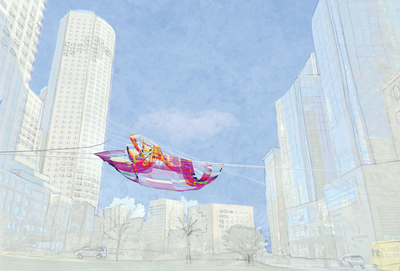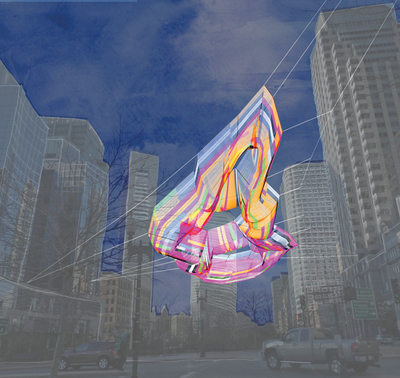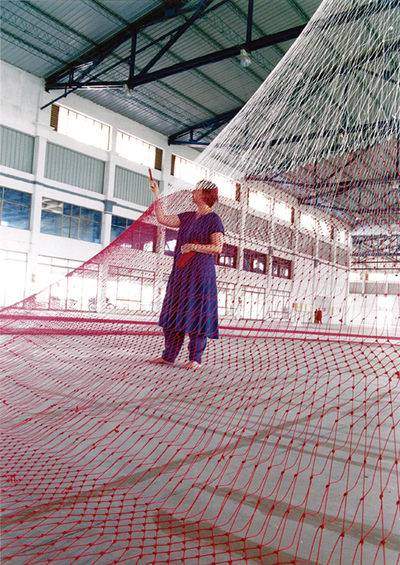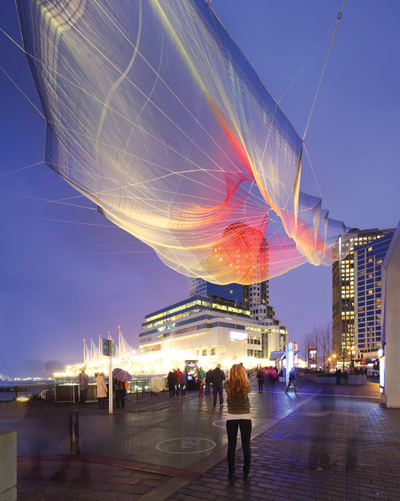Blowin’ in the Wind
Echelman’s Skies Painted with Unnumbered Sparks at the TED Conference’s 30th anniversary, spanning 745 feet from a 24-story building and the Vancouver Convention Center. Photo: Ema Peter.
When public artist Janet Echelman was a Harvard freshman in the 1980s, she set off to visit the North End and found herself having to traverse the shady no-man’s land under the Central Artery. The elevated highway ran imposingly between downtown and the waterfront.
“How bewildered I was, encountering the highway, the overpass,” says Echelman, leaning back in a chair in her Brookline studio. “The message that you don’t belong as a pedestrian was so clear.”
The Central Artery is gone, and the Rose Fitzgerald Kennedy Greenway unfurls like a ribbon of parkland along its route. In May, workers will install a massive, fluid, soft sculpture that billows 600 feet through the air over the Greenway and the city. For six months, it will be suspended over the north end of the Fort Point Channel Park between Pearl and Oliver streets. Its anchors: International Place, the InterContinental Hotel and 125 High Street.
The Rose Fitzgerald Kennedy Greenway Conservancy tapped Echelman after rolling out its five-year public art master plan and soliciting proposals for temporary projects.
“It’s magical,” says Lucas Cowan, the conservancy’s public art curator. “Janet creates these situations that are unexpected. They remind me of deep-sea jellyfish—translucent, moving with the water. It’s like watching a living, breathing thing.”
“Nothing about this relates to traditional sculpture,” Echelman says. “There’s no pedestal. It’s a lightweight piece about interrelationships, responsiveness and resiliency.”
When designing the Greenway project, which was still untitled at press time, Echelman considered the long history of the area.
“A maintenance person at High Street told me they had the granite from the sea wall from when John Adams had his office there,” Echelman says. Back in the day, the Greenway site was in Boston Harbor.
“I started thinking about the layers of intervention we people have done with our landscape in this one site, where patriots threw barrels of tea into the harbor,” she says.
The crests of Boston’s three original hills were lopped off in the early 19th century to create landfill. Echelman’s design includes three voids to echo those hills.
“The city rose up,” the artist says. “Then the city was bulldozed to create the Central Artery.”
Green passages in the net recall the green paint along the highway—“The other green monster,” notes Echelman—and the design’s bands echo the width of highway lanes.
The netting itself can be seen as a metaphor for Boston’s urban fabric, which the Greenway, as parkland, also celebrates.
For all its allusions, though, the project will be what the viewer makes of it. “I wanted a place where people could be on the grass underneath it, and lie back and look up and watch the patterns of the wind,” Echelman says.
Top and bottom: Studio Echelman’s rendering of its upcoming sculpture for Boston, shown here at different views during the day and at night.
In the daytime, the colorful netting will ripple against a background of sky and clouds. At night, it will be a scrim for projected color. Echelman’s immense soft and mobile sculptures make lyrical counterpoints to the hard edges and straight lines of a city.
“If everything about our city is made of rigid materials and immoveable, and you encounter a structure the size of a building yet soft and dynamically shifting, it calls into question the status quo,” says the artist. “It’s a relief on some palpable level. You take it in with your body.”
Although this is her first commission in Boston, Echelman has been designing netted sculptures for 18 years. The first one came about when she traveled to India on a Fulbright Senior Lectureship. She was a painter at the time, but her paints were lost in transit. Without a medium, the artist noticed the local fishermen bundling nets, and decided to learn how to make them. She mounted her pieces on poles and watched them catch the wind.
In a picture of Echelman in front of Wide Hips, one of her early pieces along an Indian beach, tiny people in the distance make the work look much larger than it was.
“It shows you my intention,” Echelman says.
She has the picture on display in her office, along with artwork by her children, paintings she made back when she was a painter, and a wall full of colorful knots of cord. Five assistants work in the next room, a spacious studio, where delicate nets—models for other projects—drape from the ceiling.
Over the years, Echelman has gone from employing local fishermen to knot nets to designing monumental projects that require cutting-edge technology—computer modeling, newer and stronger synthetic fibers, light projection responsive to the wind, and more.
In Phoenix in 2009, she worked with a roller-coaster manufacturer to bend the metal armature for her piece Her Secret is Patience. Softer netting that drifts on the breezes fastens to that armature.
In 2015, that’s old school. The Greenway piece replaces the metal with lightweight ropes made of fiber 15 times stronger than steel. What was once an immovable factor in Echelman’s work is now soft and mobile.
Still, much of the netting is hand-knotted, using age-old techniques.
“You think of this as highly engineered, at the limits of material science,” Echelman says. “Yet the method—splicing and knotting rope—has been around for millennia. There’s something so humbling about it, and everyone understands it.”
Top: Echelman working on her 2001 sculpture Floor Target in Coimbatore, India. Bottom: Echelman’s first permanent, monumental sculpture She Changes, installed in Porto, Portugal, in 2005, which has become a local icon where people continue to gather. Photo: Enrique Diaz.
Each project provides a new challenge. The technology for the Greenway effort is similar to Echelman’s Skies Painted with Unnumbered Sparks, last year’s temporary installation in Vancouver for the TED conference’s 30th anniversary. But weather introduces new issues in Boston. The piece is higher, and will meet stronger winds, which will play Echelman’s sculpture like a pianist plays a piano.
The artist has been working with software company Autodesk, which underwrote the partnership as a strategic initiative, to help envision all the variables. Designers built on Maya, Autodesk’s popular three-dimensional animation software, to calculate the weave of a net and the color, thickness and elasticity of its cord.
“It takes into account the net as it is made, and then what challenges it when it’s subject to gravity loads,” says Rick Rundell, senior director, technology and innovation strategist at Autodesk. “Then, what happens when the wind blows.”
“This is probably one of the most technically complex projects the Greenway has taken on, or maybe since the Big Dig, in this area,” says Cowan. “It’s not plop art.”
Indeed, Echelman’s project is perhaps the largest public art project the city has undertaken. A team of engineers, contractors, designers and project managers has enabled the Greenway Conservancy to be nimble.
“We’ve been able to communicate quickly,” says Cowan, who cites enthusiastic support from neighbors and from Mayor Martin J. Walsh’s office. It doesn’t take a village to raise one of Echelman’s artworks—it takes a city.
With a lot of preparation, installation will transpire fairly quickly before the formal opening on May 11. The streets will be closed for one night while the project is hoisted. Six days are allotted for tinkering.
Skies Painted with Unnumbered Sparks included an interactive lighting program in which visitors were able to choreograph the lighting in real time using physical gestures on their mobile devices. Photo: Ema Peter. All images courtesy of Studio Echelman.
“It’s been hard. Every project is,” says Echelman. “Figuring out what is the right artwork for the site, what does the site call forth. Every time I’m able to build a piece, I always think it’s a miracle.”
The artist has many new projects in the works, including Pulse, a grounded, ethereal work opening later this year in a park adjoining Philadelphia’s city hall: Illuminated curtains of mist will trace the path of subway trains passing below. Other efforts are afoot along Sunset Strip in West Hollywood, in Greensboro, NC, and at the Smithsonian American Art Museum.
But this first hometown project holds a special meaning for Echelman. Although she was commissioned in 2014, she has been thinking about a possible Greenway installation for years. Now it has come to fruition.
She and her family were watching a Patriots game on television this past season, and during a break, a skycam soared over Boston. Next fall, the blimp soaring over the city will capture the voluptuous movement and colors of Echelman’s work billowing over the Greenway.
Cate McQuaid is a critic for the Boston Globe.






